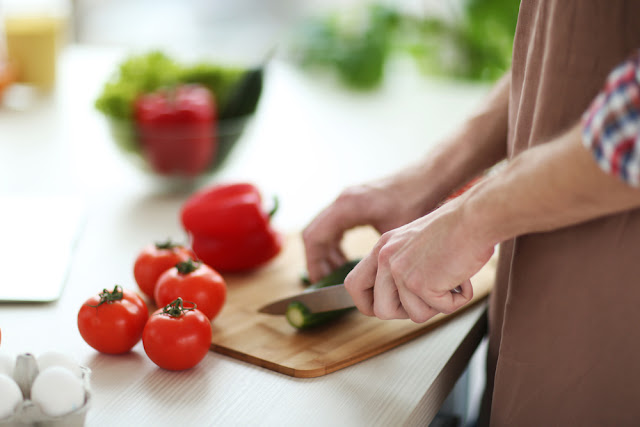 |
| Photo: Shutterstock |
7 Kitchen Tools ... the Essentials:
1) A Sharp chef knife - Slice and dice away! A sharp chef knife is indispensable to prepare fresh, healthy, real food such as fruits, vegetables and salads daily to keep us healthy. I use a 5" Santouku knife as my chef knife. (I was gifted a 7'' too, but really only use the larger size to slice whole watermelon.)
2) Microwave oven - Once I had a mid-size, but replaced it with a Sharp Carousel 1.4 cubic feet size. Don't let the compact size fool you! Reheats food on an 11 inch plate in 2 -3 minutes flat! You can also cook raw vegetables, make popcorn and melt butter or cheese fast. Such a useful kitchen tool for cooking meals in minutes.
 |
| Photo: Shutterstock |
I rarely grab other sizes, but use these pans continuously. Plus, I use my cast iron skillet to bake cornbread, pizza (from scratch), steaks, salmon and cheesecake. What a heat conductor cast iron is; food cooks evenly! A 12 inch chef skillet eliminates the need for 3 - 4 other pans. It is great for boiling whole spaghetti, as well as, cooking one-pan meat, starch and vegetable stews. I adore the easy-breezy clean-up of simmering one-pan meals!
One non-stick skillet to fry an egg is all you will ever need. Or you could just use your seasoned cast iron skillet (to save a purchase). I own both, but it isn't necessary.
4) Baking pans - Mine are Nordic Ware -100% aluminum: (a) 2 - 17'' by 12'' baking sheets; (b) one medium baking sheet (see why below); (C) 9'' by 9'' square baking pan; (d) 2 - 9'' round cake pans - You can do every kind of baking, browning and grilling with these common sizes.
I use the medium baking sheet as a shield against spills of cake batter or casserole juices. Avoid having to clean a mess in your oven at all cost! I use a medium inexpensive baking sheet instead of my better Nordic Ware baking sheets.
I also have a Nordic aluminum loaf pan, but usually grab my cast iron skillet for baking meatloaf and bread. Can't beat this old standby! So the loaf pan is rarely used.
I use the medium baking sheet as a shield against spills of cake batter or casserole juices. Avoid having to clean a mess in your oven at all cost! I use a medium inexpensive baking sheet instead of my better Nordic Ware baking sheets.
I also have a Nordic aluminum loaf pan, but usually grab my cast iron skillet for baking meatloaf and bread. Can't beat this old standby! So the loaf pan is rarely used.
5) Osterizer blender - Costs about $25. An Osterizer is the pioneer of kitchen blenders. It is powerful, durable and does everything, including crushing ice for smoothies that the fancy $100+ blenders do. Eventually all blenders blow out with constant use, but it hurts less to replace this 14-speed super-trouper! So why spend more?
6) Food processor - 3 cup size - Not too big, not too small. Mostly I grind nuts in it. Sometimes I make low calorie ice cream too: Toss in a sliced frozen banana, drops of milk and pulse! Easy to store and half the price of the big boys. Unless you always prepare big batches of food, this size is plenty.
6) Food processor - 3 cup size - Not too big, not too small. Mostly I grind nuts in it. Sometimes I make low calorie ice cream too: Toss in a sliced frozen banana, drops of milk and pulse! Easy to store and half the price of the big boys. Unless you always prepare big batches of food, this size is plenty.
7) Hand held mixer - I bought a Black and Decker hand-held mixer with 6 speeds at a drug store about 20 years ago, which I use to mix all my cake batters and pasty. Best $12 I ever spent as it is still going strong. Sans fancy bells and whistles, the small mixer does everything a Big Stationary Mixer does, and the cakes and cookies turn out great. Heck, I burn a few calories by holding and twirling it around. This buy taught me to stick with the basics.
So now let's include your experience. What Kitchen Tool Essentials can you not live without? The best bang for your buck is ...
You may also enjoy:
Shelf Helpers To Organize
Selecting The Right Houseplants
Do You Have A Design Challenge?
The Best Places To Go For Antiques And Home Decor
So now let's include your experience. What Kitchen Tool Essentials can you not live without? The best bang for your buck is ...
You may also enjoy:
Shelf Helpers To Organize
Selecting The Right Houseplants
Do You Have A Design Challenge?
The Best Places To Go For Antiques And Home Decor
























